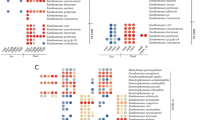Abstract
Biological control is being considered as an alternative or a supplemental way of reducing the use of chemicals in agriculture. An endophytic strain G3 with potential as a biocontrol agent was isolated from the stems of Triticum aestivum L. It was classified by 16S rDNA sequencing as a member of Serratia. Strain G3 displayed a broad spectrum of antifungal activity in vitro against a number of phytopathogens such as Botrytis cinerea, Cryphonectria parasitica, Rhizoctonia cerealis and Valsa sordida. Molecular mechanisms involved in biocontrol by Serratia sp. G3 was investigated for its potential application to plant health management. The results showed that G3 produces an array of antimicrobial exoproducts, including chitinase, protease, antibiotic pyrrolnitrin, and siderophores for iron competition. Moreover, it also produced the plant growth hormone indole-3-acetic acid, suggesting that multiple mechanisms and their synergistic effects may be involved in biocontrol of plant diseases. Additionally, strain G3 can produce at least ten N-acyl homoserine lactones (AHLs) signal molecules for cell to cell communication, including unsubstituted, 3-oxo, and 3-hydroxy at the C3 position through liquid chromatography-tandem mass spectrometry (LC-MS/MS), which is different from the previously reported Serraia species. For the first time, N-3-oxo-heptanoyl-homoserine lactone, one of the main molecules was reported in the genus Serratia. The role of AHL-dependent quorum sensing system in the interactions between the endophytic strain G3 and host plants and its potential application in improving biocontrol efficacy will be further explored.



Similar content being viewed by others
References
Ausubel FM, Brendt R, Kingston RE, Moore DD, Seidman JG, Smith JA, Struhl K (1994) Current protocols in molecular biology. Wiley, New York
Barriuso J, Ramos Solano B, Fray RG, Cámara M, Hartmann A, Gutiérrez Mañero FJ (2008) Transgenic tomato plants alter quorum sensing in plant growth-promoting rhizobacteria. Plant Biotechnol J 6:442–452
Compant S, Duffy B, Nowak J, Clement C, Barkal EA (2005) Use of plant growth-promoting bacteria for biocontrol of plant diseases: principles, mechanisms of action, and future prospects. Appl Environ Microbiol 71:4951–4959
Crozier A, Arruda P, Jasmim JM, MonteiroA M, Sandber G (1988) Analysis of indole-3-acetic acid and related indoles in culture medium from Azospirillum lipoferum and Azospirillum brasilense. Appl Environ Microbiol 54:2833–2837
de Vleeschauwer D, Höfte M (2007) Using Serratia plymuthica to control fungal pathogens of plant. CAB Rev 2:046
Dubuis C, Keel C, Haas D (2007) Dialogues of root-colonizing biocontrol pseudomonads. Eur J Plant Pathol 119:311–328
Gurtler V, Stanisich VA (1996) New approaches to typing and identification of bacteria using the 16S–23S rDNA spacer region. Microbiology 142:3–16
Kamensky M, Ovadis M, Chet I, Chernin L (2003) Soil-borne strain IC14 of Serratia plymuthica with multiple mechanisms of antifungal activity provides biocontrol of Botrytis cinerea and Sclerotinia sclerotiorum diseases. Soil Biol Biochem 35:323–331
Kobayashi D, Palumbo JD (2000) Bacterial endophytes and their effects on plants and uses in agriculture. In: Bacon CW, White JF (eds) Microbial endophytes. MarcelDekker, NewYork, pp 199–233
Liu X, Bimerew M, Ma Y, Muller H, Ovadis M, Eberl L, Berg G, Chernin L (2007) Quorum-sensing signaling is required for production of the antibiotic pyrrolnitrin in a rhizospheric biocontrol strain of Serratia plymuthica. FEMS Microbiol Lett 270:299–305
Long HH, Schmidt DD, Baldwin IT (2008) Native bacterial endophytes promote host growth in a species-specific manner; phytohormone manipulations do not result in common growth responses. PLoS ONE 3(7):e2702
Lorck H (1948) Production of hydrocyanic acid by bacteria. Physiol Plant 1:142–146
McClean KH, Winson MK, Fish L, Taylor A, Chabra SR, Camara M, Daykin M, Lamb JH, Swift S, Bycroft BW, Stewart GSAB, Williams P (1997) Quorum sensing in Chromobacterium violaceum: exploitation of violacein production and inhibition for the detection of N-acylhomoserine lactones. Microbiology 143:3703–3711
Mercado-Blanco J, Bakker PAHM (2007) Interactions between plants and beneficial Pseudomonas spp.: exploiting bacterial traits for crop protection. Antonie van Leeuwenhoek 92:367–389
Muller H, Westendorf C, Leitner E, Chernin L, Riedel K, Schmidt S, Eberl L, Berg G (2009) Quorum-sensing effects in the antagonistic rhizosphere bacterium Serratia plymuthica HRO-C48. FEMS Microbiol Ecol 67:468–478
Ortori CA, Atkinson S, Chhabra SR, Cámara M, Williams P, Barrett A (2007) Comprehensive profiling of N-acylhomoserine lactones produced by Yersinia pseudotuberculosis using liquid chromatography coupled to hybrid quadrupole-linear ion trap mass spectrometry. Anal Bioanal Chem 387:497–511
Ovadis M, Liu X, Gavriel S, Ismailov Z, Chet I, Chernin L (2004) The global regulator genes from biocontrol strain Serratia plymuthica IC1270: cloning, sequencing, and functional studies. J Bacteriol 186:4986–4993
Pang Y, Liu X, Ma Y, Chernin L, Berg G, Gao K (2009) Induction of systemic resistance, root colonization and biocontrol activities of the rhizospheric strain of Serratia plymuthica are dependent on N-acyl homoserine lactones. Eur J Plant Pathol 124:261–268
Ryan RP, Germaine K, Franks A, Ryan DJ, Dowling DN (2008) Bacterial endophytes: recent developments and applications. FEMS Microbiol Lett 278:1–9
Schwyn B, Neilands JB (1987) Universal chemical assay for the detection and determination of siderophores. Anal Biochem 160:47–56
Taghavi S, Garafola C, Monchy S, Newman L, Hoffman A, Weyens N, Barac T, Vangronsveld J, van der Lelie D (2009) Genome survey and characterization of endophytic bacteria exhibiting a beneficial effect on growth and development of poplar trees. Appl Environ Microbiol 75:748–757
Van Houdt R, Givskov M, Michiels CW (2007) Quorum sensing in Serratia. FEMS Microbiol Rev 31:407–424
Zhang Y, Fernando WGD, de Kievit TR, Berry C, Daayf F, Paulitz TC (2006) Detection of antibiotic-related genes from bacterial biocontrol agents with polymerase chain reaction. Can J Microbiol 52:476–481
Acknowledgments
We thank Ortori CA for LC-MS/MS analysis. This work was funded by the National Natural Science Foundation of China (NSFC, grant nos. 30670030 and 30370954), NSFC-RS joint project (no. 30811130218), and the senior talent funds of Jiangsu University (07JDG030). Note: The authors declare that they have no conflict of interest.
Author information
Authors and Affiliations
Corresponding author
Rights and permissions
About this article
Cite this article
Liu, X., Jia, J., Atkinson, S. et al. Biocontrol potential of an endophytic Serratia sp. G3 and its mode of action. World J Microbiol Biotechnol 26, 1465–1471 (2010). https://doi.org/10.1007/s11274-010-0321-y
Received:
Accepted:
Published:
Issue Date:
DOI: https://doi.org/10.1007/s11274-010-0321-y




